Transition words英文写作中的过渡词
- 格式:doc
- 大小:59.50 KB
- 文档页数:2
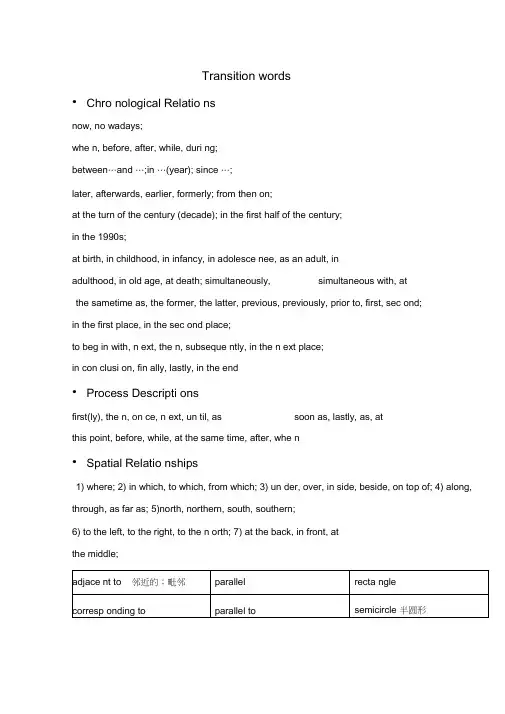
Transition words•Chro nological Relatio nsnow, no wadays;whe n, before, after, while, duri ng;between…and …;in …(year); since …;later, afterwards, earlier, formerly; from then on;at the turn of the century (decade); in the first half of the century;in the 1990s;at birth, in childhood, in infancy, in adolesce nee, as an adult, inadulthood, in old age, at death; simultaneously, simultaneous with, atthe sametime as, the former, the latter, previous, previously, prior to, first, sec ond;in the first place, in the sec ond place;to beg in with, n ext, the n, subseque ntly, in the n ext place;in con clusi on, fin ally, lastly, in the end•Process Descripti onsfirst(ly), the n, on ce, n ext, un til, as soon as, lastly, as, atthis point, before, while, at the same time, after, whe n•Spatial Relatio nships1) where; 2) in which, to which, from which; 3) un der, over, in side, beside, on top of; 4) along, through, as far as; 5)north, northern, south, southern;6) to the left, to the right, to the n orth; 7) at the back, in front, atthe middle;• Givi ng Specific Details• Making Comparis on and Con trast• Discuss ing Cause and EffectMake …possible; make it possible/impossible for …to do。
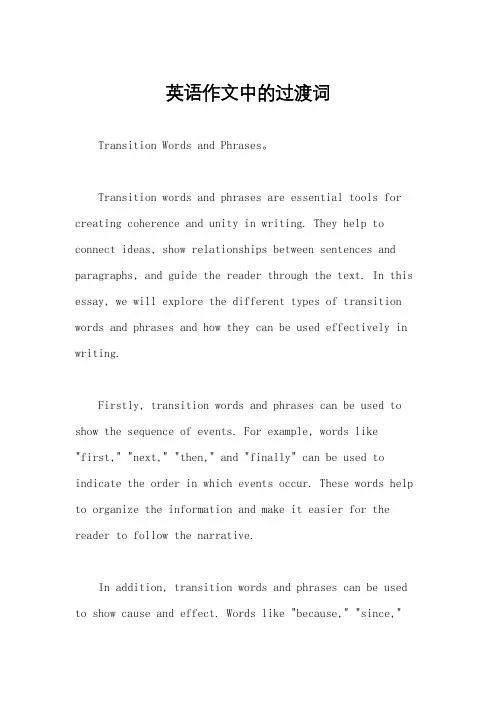
英语作文中的过渡词Transition Words and Phrases。
Transition words and phrases are essential tools for creating coherence and unity in writing. They help to connect ideas, show relationships between sentences and paragraphs, and guide the reader through the text. In this essay, we will explore the different types of transition words and phrases and how they can be used effectively in writing.Firstly, transition words and phrases can be used to show the sequence of events. For example, words like "first," "next," "then," and "finally" can be used to indicate the order in which events occur. These words help to organize the information and make it easier for the reader to follow the narrative.In addition, transition words and phrases can be used to show cause and effect. Words like "because," "since,""as a result," and "therefore" help to explain the reasons why something happened. They show the relationship between different ideas and help to make the writing morepersuasive and logical.Furthermore, transition words and phrases can be usedto compare and contrast different ideas. Words like "similarly," "likewise," "on the other hand," and "however" help to show the similarities and differences between twoor more things. This can be particularly useful in academic writing, where it is important to present a balanced argument.Moreover, transition words and phrases can be used to show examples or provide further information. Words like "for example," "in addition," "furthermore," and "moreover" help to illustrate the points being made and provide evidence to support them. This can help to make the writing more convincing and persuasive.In conclusion, transition words and phrases areessential tools for creating coherence and unity in writing.They help to connect ideas, show relationships between sentences and paragraphs, and guide the reader through the text. By using transition words and phrases effectively, writers can make their writing more organized, logical, and persuasive. Therefore, it is important for writers to understand the different types of transition words and phrases and how they can be used to improve their writing.。
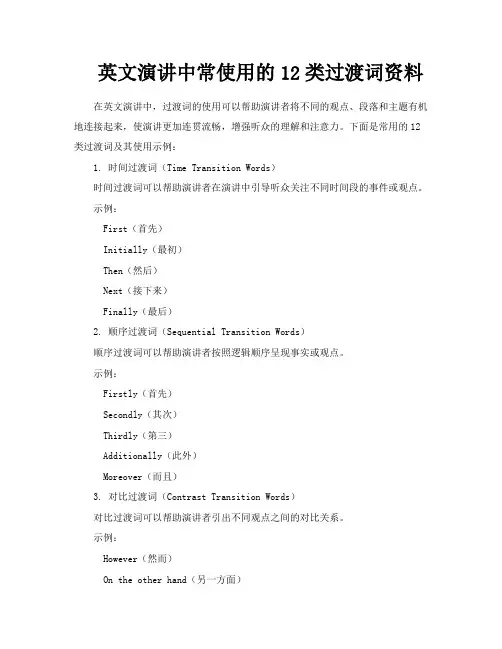
英文演讲中常使用的12类过渡词资料在英文演讲中,过渡词的使用可以帮助演讲者将不同的观点、段落和主题有机地连接起来,使演讲更加连贯流畅,增强听众的理解和注意力。
下面是常用的12类过渡词及其使用示例:1. 时间过渡词(Time Transition Words)时间过渡词可以帮助演讲者在演讲中引导听众关注不同时间段的事件或观点。
示例:First(首先)Initially(最初)Then(然后)Next(接下来)Finally(最后)2. 顺序过渡词(Sequential Transition Words)顺序过渡词可以帮助演讲者按照逻辑顺序呈现事实或观点。
示例:Firstly(首先)Secondly(其次)Thirdly(第三)Additionally(此外)Moreover(而且)3. 对比过渡词(Contrast Transition Words)对比过渡词可以帮助演讲者引出不同观点之间的对比关系。
示例:However(然而)On the other hand(另一方面)In contrast(相比之下)Nevertheless(然而)Nonetheless(尽管如此)4. 例证过渡词(Illustration Transition Words)例证过渡词可以帮助演讲者举例说明某个观点或论点。
示例:For example(例如)For instance(举例来说)In particular(特别是)Specifically(具体来说)To illustrate(为了说明)5. 因果过渡词(Cause and Effect Transition Words)因果过渡词可以帮助演讲者表达原因和结果之间的关系。
示例:Because(因为)Therefore(因此)Consequently(因此)Thus(因此)As a result(结果)6. 解释过渡词(Explanation Transition Words)解释过渡词可以帮助演讲者解释某个概念、观点或现象。
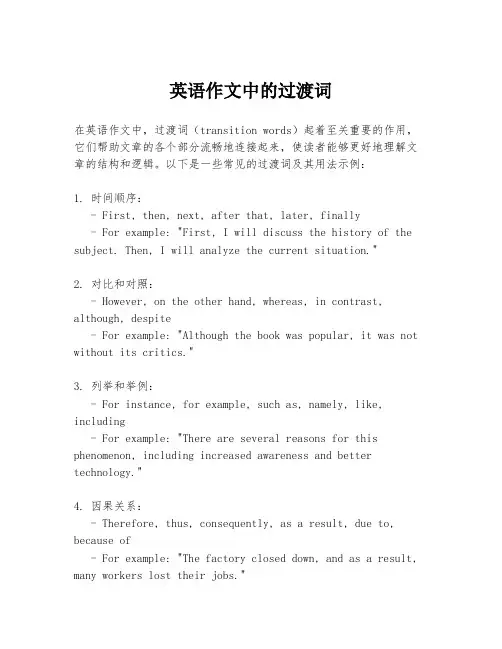
英语作文中的过渡词在英语作文中,过渡词(transition words)起着至关重要的作用,它们帮助文章的各个部分流畅地连接起来,使读者能够更好地理解文章的结构和逻辑。
以下是一些常见的过渡词及其用法示例:1. 时间顺序:- First, then, next, after that, later, finally- For example: "First, I will discuss the history of the subject. Then, I will analyze the current situation."2. 对比和对照:- However, on the other hand, whereas, in contrast, although, despite- For example: "Although the book was popular, it was not without its critics."3. 列举和举例:- For instance, for example, such as, namely, like, including- For example: "There are several reasons for this phenomenon, including increased awareness and better technology."4. 因果关系:- Therefore, thus, consequently, as a result, due to, because of- For example: "The factory closed down, and as a result, many workers lost their jobs."5. 总结:- In conclusion, to sum up, in summary, overall, finally, in brief- For example: "In conclusion, the evidence clearly supports the theory."6. 递进:- Moreover, furthermore, in addition, also, besides,what's more- For example: "Furthermore, the new policy will also benefit the environment."7. 强调:- Indeed, certainly, undoubtedly, in fact, truly, actually - For example: "Indeed, the new findings have revolutionized our understanding of the disease."8. 顺序:- First of all, secondly, thirdly, lastly, to begin with, to continue- For example: "First of all, the evidence is compelling. Secondly, the implications are far-reaching."9. 条件:- If, unless, provided that, in case, assuming that, on condition that- For example: "If we act now, we can prevent further damage."10. 让步:- Although, even though, even if, despite, notwithstanding- For example: "Even if the odds are against us, we must continue to strive for success."使用这些过渡词,你的英语作文将更加流畅和有说服力。
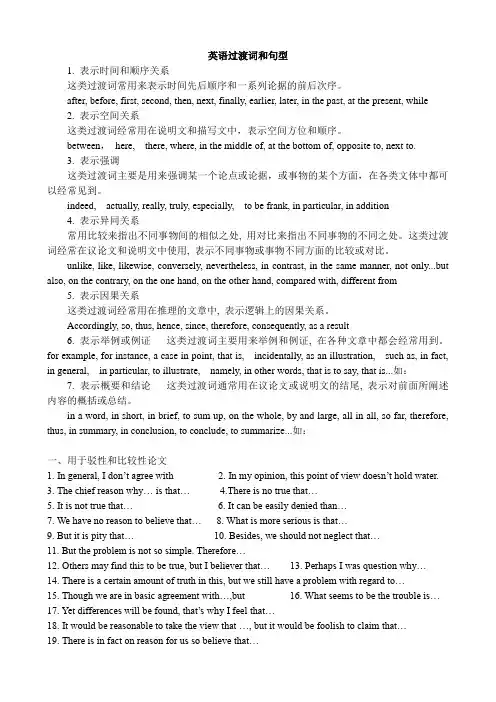
英语过渡词和句型1. 表示时间和顺序关系这类过渡词常用来表示时间先后顺序和一系列论据的前后次序。
after, before, first, second, then, next, finally, earlier, later, in the past, at the present, while2. 表示空间关系这类过渡词经常用在说明文和描写文中,表示空间方位和顺序。
between,here, there, where, in the middle of, at the bottom of, opposite to, next to.3. 表示强调这类过渡词主要是用来强调某一个论点或论据,或事物的某个方面,在各类文体中都可以经常见到。
indeed, actually, really, truly, especially, to be frank, in particular, in addition4. 表示异同关系常用比较来指出不同事物间的相似之处, 用对比来指出不同事物的不同之处。
这类过渡词经常在议论文和说明文中使用, 表示不同事物或事物不同方面的比较或对比。
unlike, like, likewise, conversely, nevertheless, in contrast, in the same manner, not only...but also, on the contrary, on the one hand, on the other hand, compared with, different from5. 表示因果关系这类过渡词经常用在推理的文章中, 表示逻辑上的因果关系。
Accordingly, so, thus, hence, since, therefore, consequently, as a result6. 表示举例或例证这类过渡词主要用来举例和例证, 在各种文章中都会经常用到。

英语初中作文过渡单词Transition Words in English Composition。
Transition words are important in English composition as they help to connect ideas and guide the reader through the text. They serve as bridges between paragraphs and help to maintain the flow of the writing. In this essay, we will explore the various transition words that can be used in English composition and how they can enhance the overall quality of the writing.Firstly, transition words such as "firstly," "secondly," and "thirdly" can be used to introduce a series of points or ideas. For example, in an essay about the benefits of exercise, the writer might use transition words like "firstly, exercise helps to improve physical health," "secondly, it can boost mental well-being," and "thirdly,it can increase energy levels." These transition words help to organize the information in a clear and logical manner.In addition to introducing a series of points, transition words can also be used to compare and contrast different ideas. Words like "however," "on the other hand," and "in contrast" can be used to show the differences between two concepts. For example, in a persuasive essay about the importance of recycling, the writer might use transition words like "on the one hand, recycling helps to reduce waste and protect the environment, however, some people argue that it is too time-consuming and inconvenient." These transition words help to present a balanced argument and consider different perspectives.Furthermore, transition words can be used to show cause and effect relationships. Words like "because," "since," and "as a result" can be used to explain why something happened or the consequences of a particular action. For example, in an essay about the impact of social media on society, the writer might use transition words like "because of social media, people can easily connect with others around the world," "as a result, communication has become more instant and widespread." These transition words help to clarify the relationship between different ideasand events.Moreover, transition words can be used to provide examples or support for a particular argument. Words like "for example," "in addition," and "furthermore" can be used to introduce evidence or further information. For instance, in an essay about the benefits of reading, the writer might use transition words like "for example, reading can improve vocabulary and language skills," "in addition, it can enhance critical thinking and analytical abilities." These transition words help to strengthen the argument and provide a more convincing case.In conclusion, transition words are essential in English composition as they help to organize ideas, connect paragraphs, and guide the reader through the text. By using transition words effectively, writers can create a coherent and cohesive piece of writing that is easy to follow and understand. Whether introducing a series of points, comparing and contrasting ideas, showing cause and effect relationships, or providing examples and support,transition words play a crucial role in enhancing the overall quality of the composition.。
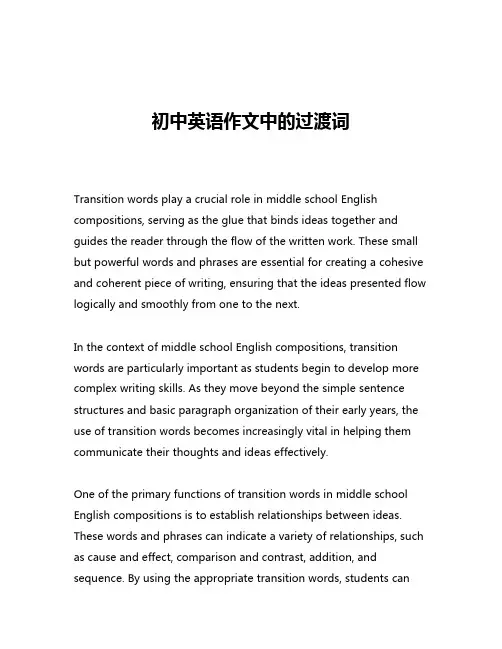
初中英语作文中的过渡词Transition words play a crucial role in middle school English compositions, serving as the glue that binds ideas together and guides the reader through the flow of the written work. These small but powerful words and phrases are essential for creating a cohesive and coherent piece of writing, ensuring that the ideas presented flow logically and smoothly from one to the next.In the context of middle school English compositions, transition words are particularly important as students begin to develop more complex writing skills. As they move beyond the simple sentence structures and basic paragraph organization of their early years, the use of transition words becomes increasingly vital in helping them communicate their thoughts and ideas effectively.One of the primary functions of transition words in middle school English compositions is to establish relationships between ideas. These words and phrases can indicate a variety of relationships, such as cause and effect, comparison and contrast, addition, and sequence. By using the appropriate transition words, students canclearly convey the connections between their thoughts, making it easier for the reader to follow the flow of the essay.For example, consider the following two sentences without any transition words:The weather was sunny today. I decided to go for a walk.While these sentences convey related information, the lack of a transition word makes the connection between them less clear. By adding a transition word, the relationship becomes more evident:The weather was sunny today. Therefore, I decided to go for a walk.In this case, the transition word "therefore" indicates a cause-and-effect relationship, making it clear that the sunny weather led to the decision to go for a walk.Similarly, transition words can be used to compare and contrast ideas:Hiking is a great way to exercise. In contrast, running is a more intense workout.Here, the transition word "in contrast" signals that the secondsentence is presenting a different perspective on the topic of exercise.Transition words can also be used to introduce additional information or ideas:I enjoy hiking because it allows me to connect with nature. Moreover, it is a great way to relieve stress.The transition word "moreover" in this example indicates that the second sentence is adding a further benefit to the first.In middle school English compositions, the effective use of transition words can significantly improve the overall quality and coherence of the writing. Students who are able to seamlessly incorporate these words and phrases into their essays demonstrate a stronger grasp of the language and a greater understanding of how to structure their thoughts in a clear and logical manner.Furthermore, the use of transition words can also help students develop their writing style and voice. By selecting the appropriate transition words, students can convey different tones and attitudes, ranging from formal and academic to more casual and conversational. This flexibility allows them to tailor their writing to the specific requirements of the assignment and the audience theyare addressing.It is important to note, however, that the overuse of transition words can also be problematic. Students should be mindful of using them judiciously and only when they genuinely serve to enhance the flow and clarity of the writing. Excessive or inappropriate use of transition words can make the writing sound stilted or artificial, detracting from the overall quality and effectiveness of the composition.To ensure the effective use of transition words in middle school English compositions, students should be encouraged to familiarize themselves with a wide range of these words and phrases, and to practice incorporating them into their writing in a natural and organic way. This can be achieved through targeted instruction, examples, and opportunities for guided practice and feedback.Additionally, students should be encouraged to read a variety of high-quality writing samples, both in their English classes and in their personal reading, to observe how professional writers utilize transition words to create cohesive and compelling narratives. By studying these models, students can gain a deeper understanding of how transition words function and how to apply them effectively in their own writing.In conclusion, transition words are a crucial component of middleschool English compositions, serving as the bridges that connect ideas and guide the reader through the flow of the written work. By mastering the use of these words and phrases, students can significantly improve the clarity, coherence, and overall quality of their writing, positioning themselves for success in their academic pursuits and beyond.。
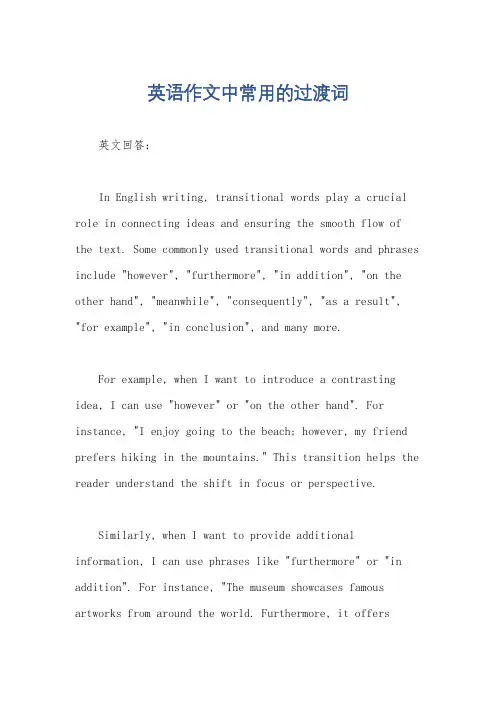
英语作文中常用的过渡词英文回答:In English writing, transitional words play a crucial role in connecting ideas and ensuring the smooth flow of the text. Some commonly used transitional words and phrases include "however", "furthermore", "in addition", "on the other hand", "meanwhile", "consequently", "as a result", "for example", "in conclusion", and many more.For example, when I want to introduce a contrasting idea, I can use "however" or "on the other hand". For instance, "I enjoy going to the beach; however, my friend prefers hiking in the mountains." This transition helps the reader understand the shift in focus or perspective.Similarly, when I want to provide additional information, I can use phrases like "furthermore" or "in addition". For instance, "The museum showcases famous artworks from around the world. Furthermore, it offersguided tours for visitors." This transition signals that more details are coming and helps maintain the reader's interest.Moreover, when I want to show cause and effect, I can use phrases like "consequently" or "as a result". For example, "I missed the bus; consequently, I arrived late to work." This transition clearly indicates the outcome of a certain action or event.In conclusion, transitional words are essential in English writing as they help create coherence and cohesion in the text. By using these words effectively, I can guide the reader through my ideas and arguments smoothly.中文回答:在英语写作中,过渡词扮演着连接思想、确保文本流畅的关键角色。
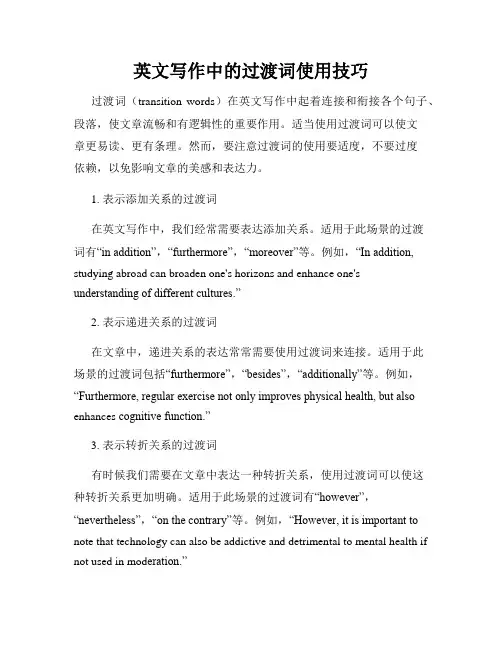
英文写作中的过渡词使用技巧过渡词(transition words)在英文写作中起着连接和衔接各个句子、段落,使文章流畅和有逻辑性的重要作用。
适当使用过渡词可以使文章更易读、更有条理。
然而,要注意过渡词的使用要适度,不要过度依赖,以免影响文章的美感和表达力。
1. 表示添加关系的过渡词在英文写作中,我们经常需要表达添加关系。
适用于此场景的过渡词有“in addition”,“furthermore”,“moreover”等。
例如,“In addition, studying abroad can broaden one's horizons and enhance one's understanding of different cultures.”2. 表示递进关系的过渡词在文章中,递进关系的表达常常需要使用过渡词来连接。
适用于此场景的过渡词包括“furthermore”,“besides”,“additionally”等。
例如,“Furthermore, regular exercise not only improves physical health, but also enhances cognitive function.”3. 表示转折关系的过渡词有时候我们需要在文章中表达一种转折关系,使用过渡词可以使这种转折关系更加明确。
适用于此场景的过渡词有“however”,“nevertheless”,“on the contrary”等。
例如,“However, it is important to note that technology can also be addictive and detrimental to mental health if not used in mod eration.”4. 表示比较关系的过渡词当我们需要对两个或多个事物进行比较时,使用过渡词可以帮助我们更好地表达。
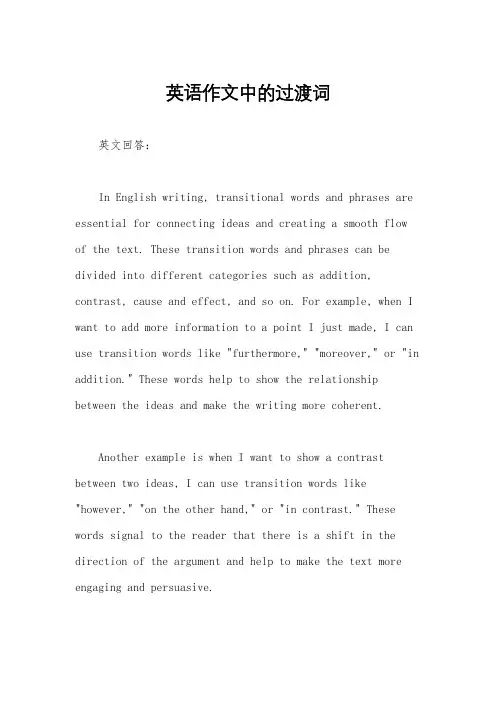
英语作文中的过渡词英文回答:In English writing, transitional words and phrases are essential for connecting ideas and creating a smooth flow of the text. These transition words and phrases can be divided into different categories such as addition, contrast, cause and effect, and so on. For example, when I want to add more information to a point I just made, I can use transition words like "furthermore," "moreover," or "in addition." These words help to show the relationship between the ideas and make the writing more coherent.Another example is when I want to show a contrast between two ideas, I can use transition words like "however," "on the other hand," or "in contrast." These words signal to the reader that there is a shift in the direction of the argument and help to make the text more engaging and persuasive.Transitional words and phrases are also important in speaking. When I give a presentation or participate in a discussion, using transition words and phrases can help me to organize my thoughts and make my speech more coherent. For instance, when I want to introduce a new point, I can use phrases like "moving on to the next point" or "let's consider another aspect." These phrases help the audience to follow my train of thought and stay engaged in the conversation.Overall, transitional words and phrases are crucial for both written and spoken English. They help to create a logical flow of ideas and make the communication more effective.中文回答:在英文写作中,过渡词和短语对于连接思想、使文本流畅不可或缺。
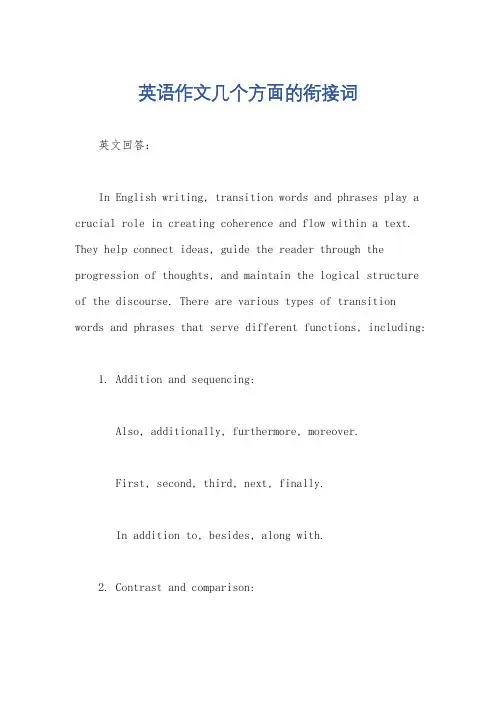
英语作文几个方面的衔接词英文回答:In English writing, transition words and phrases play a crucial role in creating coherence and flow within a text. They help connect ideas, guide the reader through the progression of thoughts, and maintain the logical structure of the discourse. There are various types of transition words and phrases that serve different functions, including:1. Addition and sequencing:Also, additionally, furthermore, moreover.First, second, third, next, finally.In addition to, besides, along with.2. Contrast and comparison:However, nevertheless, in contrast, on the contrary. Although, even though, despite.Comparatively, similarly, likewise.3. Cause and effect:Therefore, consequently, as a result.Because, since, due to.Accordingly, hence, thus.4. Exemplification and clarification:For example, for instance, such as.Namely, specifically, that is.In other words, to put it differently.5. Emphasis and concession:Notably, indeed, certainly.Granted, admittedly, it is true that.6. Summary and conclusion:In summary, to sum up, in conclusion.Finally, lastly, in closing.These are just a few examples of the extensive range of transition words and phrases available in English. By incorporating them effectively into their writing, authors can enhance the clarity, coherence, and overall readability of their texts.中文回答:在英语写作中,过渡词和短语对于创建文本内的连贯性和流动性至关重要。
英语初中作文过渡单词英文:Transition words and phrases are essential in writing to create a smooth and coherent flow in the text. They help to connect ideas, show relationships between different points, and guide the reader through the logical progression of the argument. Without proper transitions, the writing can feel disjointed and difficult to follow.One common type of transition is the addition transition, which is used to add more information to the existing point. For example, "furthermore," "in addition," and "moreover" are all addition transitions that can be used to introduce new supporting details or examples. Another type of transition is the comparison transition, which is used to show similarities or differences between ideas. Words like "similarly," "likewise," "on the other hand," and "in contrast" can be used to signal comparisons and contrasts in the text.In addition to these, there are also transitions that show cause and effect, such as "as a result," "consequently," and "therefore," as well as transitionsthat show time sequence, such as "meanwhile," "subsequently," and "finally." By using a variety of transition words and phrases, writers can ensure that their writing is clear, organized, and easy to follow.中文:过渡词和短语在写作中是至关重要的,可以帮助文章的逻辑连贯,使读者更容易理解文章的内容。
英语作文过渡词衔接词Transition Words and Phrases。
Transition words and phrases are essential tools for creating coherent and logical connections between ideas in a paper. They help to guide the reader through the text and make the writing more fluid and easy to follow. In this essay, we will explore the various types of transition words and phrases, their functions, and how to use them effectively in writing.First and foremost, transition words and phrases can be classified into different categories based on their functions. One of the most common types is the addition transition, which is used to add information to theexisting point. Examples of addition transitions include "furthermore," "moreover," "in addition," and "also." These words and phrases are crucial for building on an argument or providing further evidence to support a claim.Another important category of transition words and phrases is the comparison and contrast transitions. These transitions are used to highlight similarities and differences between ideas or points. Examples of comparison transitions include "similarly," "likewise," "in the same way," while examples of contrast transitions include "however," "on the other hand," "in contrast," and "conversely." By using these transitions, writers can effectively show the relationships between different ideas and make their writing more persuasive.In addition to addition and comparison/contrast transitions, there are also cause and effect transitions, which are used to show the relationship between two events or ideas. Examples of cause transitions include "because," "since," "as a result of," while examples of effect transitions include "therefore," "consequently," "as a result," and "thus." These transitions are crucial for explaining the reasons behind certain phenomena or the consequences of specific actions.Furthermore, there are also time and sequencetransitions, which are used to show the order of events or the passage of time. Examples of time transitions include "meanwhile," "subsequently," "eventually," while examplesof sequence transitions include "first," "second," "finally," and "in conclusion." These transitions are essential for organizing information in a logical and coherent manner, especially in narrative or process writing.Moreover, it is important to note that transition words and phrases should be used judiciously and not overused. Overusing transitions can make the writing seem forced and unnatural, so it is crucial to use them sparingly and only when necessary. Additionally, it is essential to choose the right transition for the specific context and purpose ofthe writing. For instance, if the goal is to add more information, addition transitions should be used, while if the aim is to show a cause and effect relationship, cause and effect transitions should be employed.In conclusion, transition words and phrases are indispensable tools for creating coherence and logical connections in writing. By using addition,comparison/contrast, cause and effect, and time and sequence transitions effectively, writers can guide the reader through the text and make their writing more persuasive and compelling. It is important to use transitions judiciously and choose the right ones for the specific context and purpose of the writing. With the proper use of transition words and phrases, writers can create more coherent and impactful writing.。
大学英语作文过渡词Transition words are an essential component of university-level English writing. They serve to connect ideas, guide the reader through the flow of the essay, and ensure the overall coherence and cohesion of the written work. In the context of academic writing, the appropriate use of transition words can elevate the quality of a student's work, demonstrating their ability to construct a well-structured and logically organized argument.At the most fundamental level, transition words act as bridges between sentences and paragraphs, allowing the writer to move smoothly from one idea to the next. Without these linguistic signposts, the reader may struggle to follow the progression of the essay, leading to a disjointed and confusing reading experience. Transition words can be categorized into various types, each serving a specific purpose in the writing process.Additive transition words, such as "furthermore," "in addition," and "moreover," are used to introduce new ideas that build upon or complement the previous point. These words help the writerseamlessly incorporate additional information, examples, or supporting evidence into the essay. Conversely, adversative transition words, including "however," "nevertheless," and "on the other hand," signal a shift in the writer's argument, often indicating a counterpoint or a contrast to the preceding idea.Causal transition words, such as "consequently," "therefore," and "as a result," demonstrate the logical connections between causes and effects within the essay. These words are particularly important in argumentative or analytical writing, where the writer must establish clear relationships between premises and conclusions. Temporal transition words, including "first," "next," and "finally," guide the reader through the chronological development of the essay, ensuring a clear and organized progression of ideas.In addition to these common categories, transition words can also serve more specialized functions in academic writing. Clarifying transition words, such as "in other words" and "that is," help the writer rephrase or elaborate on a previous point, ensuring the reader's full comprehension. Exemplifying transition words, such as "for instance" and "for example," introduce specific illustrations or case studies to support the writer's claims.The strategic placement of transition words within an essay can also contribute to its overall coherence and flow. Effective writers oftenuse transition words at the beginning of paragraphs to signal the introduction of a new idea or a shift in the essay's direction. Transition words can also be effectively employed within sentences, connecting clauses and phrases to create a more seamless reading experience.Moreover, the choice of transition words should be tailored to the specific context and purpose of the essay. Different types of writing, such as persuasive, analytical, or reflective, may call for the use of different transition words to achieve the desired rhetorical effect. A persuasive essay, for instance, may rely more heavily on causal and adversative transition words to build a compelling argument, while a reflective essay may utilize more additive and clarifying transition words to explore personal experiences and insights.It is important to note that the overuse of transition words can also be detrimental to the quality of an essay. Excessive or inappropriate use of these linguistic devices can make the writing appear formulaic or contrived, detracting from the overall flow and clarity of the essay. Therefore, university-level writers must strike a balance, using transition words judiciously and ensuring that they serve to enhance the coherence and logical progression of the essay, rather than becoming a distraction.In conclusion, transition words are a crucial element of university-level English writing, facilitating the smooth flow of ideas and enhancing the overall coherence of the essay. By mastering the strategic use of various types of transition words, students can elevate the quality of their written work, demonstrating their ability to construct well-organized and logically compelling arguments. As with any aspect of academic writing, the effective use of transition words requires practice, attention to context, and a keen understanding of their specific functions and applications.。
英语小作文过渡词Transition Words。
Transition words are important in both writing and speaking. They help to connect ideas and show the relationships between them. By using transition words, writers and speakers can make their writing and speaking more coherent and easier to follow.Firstly, transition words can be used to show the sequence of events. For example, words like "first," "second," "next," and "finally" can be used to show the order in which events occur. This helps readers and listeners to understand the chronological order of the events being described.Secondly, transition words can be used to show cause and effect. Words like "because," "since," "so," and "therefore" can be used to show the relationship between a cause and its effect. This helps to make the connectionsbetween different ideas clearer and helps to show how one idea leads to another.In addition, transition words can be used to compare and contrast different ideas. Words like "similarly," "likewise," "on the other hand," and "however" can be used to show similarities and differences between ideas. This can help to highlight the differences between different points of view and make the writer's or speaker's argument more persuasive.Furthermore, transition words can be used to show examples and provide further information. Words like "for example," "in addition," "furthermore," and "moreover" can be used to give examples and provide additional information to support the main points being made. This can help to make the writer's or speaker's argument more convincing and help readers and listeners to understand the topic more fully.Finally, transition words can be used to conclude and summarize. Words like "in conclusion," "to sum up," "insummary," and "to conclude" can be used to signal that the writer or speaker is finishing their argument and summarizing the main points. This helps to bring the writing or speaking to a close and leave a lasting impression on the audience.In conclusion, transition words are an important tool for writers and speakers. They help to connect ideas, show relationships between them, and make writing and speaking more coherent and easier to follow. By using transition words, writers and speakers can make their arguments more persuasive and help their audience to understand their ideas more fully. Therefore, it is important for writers and speakers to use transition words effectively in their writing and speaking.。
英语中作文用的过渡词有Transition words are essential elements in writing English compositions. They help to connect different ideas and paragraphs, making the writing more coherent and logical. In this essay, I will discuss the importance of transition words and provide some examples of how they can be used effectively.Firstly, transition words help to establish the relationship between different ideas. For instance, words like "however," "nevertheless," and "yet" are used to show contrast or opposition between two ideas. On the other hand, words like "similarly," "likewise," and "in the same way" are used to show similarity or agreement between two ideas. By using these transition words, the writer can guide the reader through the different ideas and help them understand how they are related to each other.Secondly, transition words help to create a smooth flow of ideas in the writing. Without transition words, thewriting can appear disjointed and difficult to follow. For example, words like "furthermore," "moreover," and "additionally" are used to add more information to the previous idea. Similarly, words like "in conclusion," "finally," and "to sum up" are used to signal the end of the writing. By using these transition words, the writer can create a seamless transition from one idea to the next.Thirdly, transition words help to emphasize important points in the writing. For example, words like "indeed," "certainly," and "undoubtedly" are used to emphasize the writer's point of view. Similarly, words like "in fact," "actually," and "in reality" are used to provide evidence to support the writer's argument. By using these transition words, the writer can draw attention to the most important points in the writing.In conclusion, transition words are essential elements in writing English compositions. They help to establish the relationship between different ideas, create a smooth flow of ideas, and emphasize important points. By using transition words effectively, the writer can make theirwriting more coherent and logical, and guide the reader through their ideas.。
Transition words
●Chronological Relations
now, nowadays;
when, before, after, while, during;
between… and …; in …(year); since…;
later, afterwards, earlier, formerly; from then on;
at the turn of the century (decade); in the first half of the century; in the 1990s;
at birth, in childhood, in infancy, in adolescence, as an adult, in adulthood, in old age,
at death; simultaneously, simultaneous with, at the same time as, the former, the
latter, previous, previously, prior to, first, second;
in the first place, in the second place;
to begin with, next, then, subsequently, in the next place;
in conclusion, finally, lastly, in the end
●Process Descriptions
first(ly), then, once, next, until, as soon as, lastly, as, at this point,
before, while, at the same time, after, when
●Spatial Relationships
1) where; 2) in which, to which, from which; 3) under, over, inside, beside, on top of;
4) along, through, as far as; 5)north, northern, south, southern; 6) to the left, to the
right, to the north; 7) at the back, in front, at the middle;
adjacent to 邻近的;毗邻parallel rectangle
corresponding to parallel to semicircle 半圆形
Slope
Distance perpendicular to
垂直的;成直角的
Midpoint plane水平;平面Space
Interior Opposite Surface
Diagonal Overlapping Vertical 垂直的;直立;顶端Edge Pyramid Horizontal水平的
limit exterior Intersection 交叉点;相交点●Giving Specific Details
For example As an illustration
For instance In one instance
For one thing In this instance
To illustrate As an example
In other words Take (sth as) example
As follows In practice
Let me illustrate According to statistics
Let me cite as proof According to statistics evidence
●Making Comparison and Contrast
To compare:
Similar to At the same rate as Similarly As
Like, alike (just) as … so
Likewise In like manner Correspond to In the same way Correspondingly To have … in common Resemble 类似于;与…相像Common characteristics, etc. resemblance To be parallel in …
Almost the same as Both
To contrast:
Differ from Unlike
Different from While
However Whereas 鉴于;然而;反之Still In contrast to Nevertheless In opposition to Otherwise On the contrary
Even so; although On the other hand
Less/more/faster … than On the opposite side
●Discussing Cause and Effect
So; thus Accordingly As a result Hence Consequently The result of Since The consequence of Result in Due to Therefore The effect of The reason for Have an effect on As owing to For this reason For Owe … to The cause of Because Thanks of
It follows that Because of Out of
So that Such … that Seeing that So as … to Now … that For fear that Make … possible; make it possible/impossible for … to do。